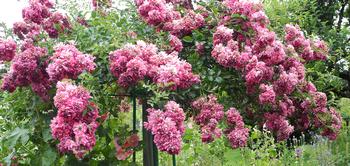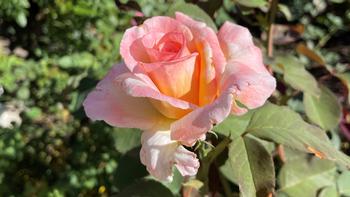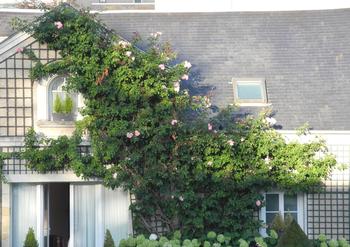
'Centenaire de Lourdes', a Floribunda standard, is a modern rose generously underplanted in Monet’s garden in Giverny. Photo: Anne-Marie Walker
For ancient Greeks, the goddess Aurora painted the dawn with roses. Romans decorated banquet halls with roses and kept secret everything said and done "sub rosa." Cleopatra welcomed Marc Antony to her palace and river barge, floors strewn with rose petals. Rose mosaics have been uncovered in Pompeii, decorate the Taj Mahal, and appear in medieval cathedral Rose windows. But for most, the fragrance of the rose is treasured as a healing power replacing painful emotions with peace, harmony, clarity, love, and joy. Roses reveal scents of tea, myrrh, and musk ad fruity scents like citrus, anise, apple, and black currant.

‘Peace,’ a Hybrid Tea Rose, is the most well-known and beloved of hybrid teas and has a long stem and lovely fragrance. Photo: Anne-Marie Walker
Some may wonder where rose scents have gone. Some historical perspective helps explain this. According to the fossil record, roses are 35 million years old. It is estimated that 100 to 150 species of the genus Rosa exist. Wild, species roses have five petal flowers, scent, rose hips rich in vitamin C and are native to Europe, North America, the Middle East, North Africa, and China. Because roses have been hybridized for hundreds of years, the American Rose Society has grouped roses as either old roses before 1867, or modern roses hybridized after 1867. Old roses include one-time bloomers Gallicas, Damasks, Albas, Centifolias, and Moss, and repeat bloomers Chinas, Bourbons, Portlands, Noisettes, Hybrid Perpetuals, and Teas. Modern roses, bred for repeating large blooms, include the classes Hybrid Tea, Polyantha, Miniature and Miniflora, Grandiflora, Floribunda, Shrub, Large-Flowered Climber, Hybrid Musk, and Hybrid Rugosa.

Old Blush’ is a China rose cultivated for 1,000+ years. Its genes are in many modern roses. Consider fire-safe practices before planting on structures
Roses are sun-loving plants thriving with six to eight hours of direct sun. With less sun, there is less flowering and more potential for disease. While some old roses, specifically the Gallicas, Damasks, and Centifolias, need dormancy (winter chill) to bloom well, roses originating or derived from the Chinas or Teas perform well in Marin gardens where winters are temperate and summers dry. 1867 proved seminal in the history of roses because it marked the development of the rose class Hybrid Tea, today’s most famous garden rose. In Paris’ Rose Garden in Parc Bagatelle, you will find many roses of Joseph Pernet-Ducher, who by 1930 had won more Medaillon d’Or (like a Rose Oscar) awards than anyone in history. When he began his career, the Tea Rose ruled the rose world. Tea roses bloom only once in a season, and Pernet-Ducher’s goal was to hybridize a re-blooming Tea rose, no easy feat as the trait is carried on a recessive gene. In 1900, he introduced ‘Soleil d’Or,’ the repeat blooming Hybrid Tea rose to which many modern roses trace their lineage. Another of his roses graces many Marin gardens; ‘Mlle. Cécile Brunner’, a Polyantha climber with pale pink repeat bloom and scents with sweet and peppery undertones. You can view roses at UC Berkeley Botanical Garden’s Garden of Old Roses, the Berkeley Rose Garden, the Rose Garden at Marin Art and Garden Center, and the Rose Garden in Golden Gate Park.

Rosa californica is our native species rose with 5 petals, scent, and rose hips rich with vitamin C. Photo: Anne-Marie Walker
Every year new roses are introduced, many of which will thrive in a wide variety of Marin gardens. While hybridization over the last 150 years has often been selected for color, repeat bloom, and disease resistance. Growers are working today to bring back fragrance so we can ‘smell the roses.’ Observation teaches warmer weather at bud time leads to a stronger scent at opening time, roses do not always smell the same year to year, and all roses on a bush may not smell the same. Lastly, you may be pleased to learn that fragrance helps attract pollinators to roses. Bees not attracted to modern commercial roses do head for old roses, especially those with single blossoms like our native California wild rose, Rosa californica. Appreciate the beauty of the rose, cultivate it, and find yourself at the edge of happiness among rose blossoms.
 'Centenaire de Lourdes', a Floribunda standard, is a modern rose generously underplanted in Monet’s garden in Giverny. Photo: Anne-Marie Walker
'Centenaire de Lourdes', a Floribunda standard, is a modern rose generously underplanted in Monet’s garden in Giverny. Photo: Anne-Marie Walker ‘Peace,’ a Hybrid Tea Rose, is the most well-known and beloved of hybrid teas and has a long stem and lovely fragrance. Photo: Anne-Marie WalkerRoses are sun-loving plants thriving with six to eight hours of direct sun. With less sun, there is less flowering and more potential for disease. While some old roses, specifically the Gallicas, Damasks, and Centifolias, need dormancy (winter chill) to bloom well, roses originating or derived from the Chinas or Teas perform well in Marin gardens where winters are temperate and summers dry. 1867 proved seminal in the history of roses because it marked the development of the rose class Hybrid Tea, today’s most famous garden rose. In Paris’ Rose Garden in Parc Bagatelle, you will find many roses of Joseph Pernet-Ducher, who by 1930 had won more Medaillon d’Or (like a Rose Oscar) awards than anyone in history. When he began his career, the Tea Rose ruled the rose world. Tea roses bloom only once in a season, and Pernet-Ducher’s goal was to hybridize a re-blooming Tea rose, no easy feat as the trait is carried on a recessive gene. In 1900, he introduced ‘Soleil d’Or,’ the repeat blooming Hybrid Tea rose to which many modern roses trace their lineage. Another of his roses graces many Marin gardens; ‘Mlle. Cécile Brunner’, a Polyantha climber with pale pink repeat bloom and scents with sweet and peppery undertones. You can view roses at UC Berkeley Botanical Garden’s Garden of Old Roses, the Berkeley Rose Garden, the Rose Garden at Marin Art and Garden Center, and the Rose Garden in Golden Gate Park.
‘Peace,’ a Hybrid Tea Rose, is the most well-known and beloved of hybrid teas and has a long stem and lovely fragrance. Photo: Anne-Marie WalkerRoses are sun-loving plants thriving with six to eight hours of direct sun. With less sun, there is less flowering and more potential for disease. While some old roses, specifically the Gallicas, Damasks, and Centifolias, need dormancy (winter chill) to bloom well, roses originating or derived from the Chinas or Teas perform well in Marin gardens where winters are temperate and summers dry. 1867 proved seminal in the history of roses because it marked the development of the rose class Hybrid Tea, today’s most famous garden rose. In Paris’ Rose Garden in Parc Bagatelle, you will find many roses of Joseph Pernet-Ducher, who by 1930 had won more Medaillon d’Or (like a Rose Oscar) awards than anyone in history. When he began his career, the Tea Rose ruled the rose world. Tea roses bloom only once in a season, and Pernet-Ducher’s goal was to hybridize a re-blooming Tea rose, no easy feat as the trait is carried on a recessive gene. In 1900, he introduced ‘Soleil d’Or,’ the repeat blooming Hybrid Tea rose to which many modern roses trace their lineage. Another of his roses graces many Marin gardens; ‘Mlle. Cécile Brunner’, a Polyantha climber with pale pink repeat bloom and scents with sweet and peppery undertones. You can view roses at UC Berkeley Botanical Garden’s Garden of Old Roses, the Berkeley Rose Garden, the Rose Garden at Marin Art and Garden Center, and the Rose Garden in Golden Gate Park. Old Blush’ is a China rose cultivated for 1,000+ years. Its genes are in many modern roses. Consider fire-safe practices before planting on structuresEvery year new roses are introduced, many of which will thrive in a wide variety of Marin gardens. While hybridization over the last 150 years has often been selected for color, repeat bloom, and disease resistance. Growers are working today to bring back fragrance so we can ‘smell the roses.’ Observation teaches warmer weather at bud time leads to a stronger scent at opening time, roses do not always smell the same year to year, and all roses on a bush may not smell the same. Lastly, you may be pleased to learn that fragrance helps attract pollinators to roses. Bees not attracted to modern commercial roses do head for old roses, especially those with single blossoms like our native California wild rose, Rosa californica. Appreciate the beauty of the rose, cultivate it, and find yourself at the edge of happiness among rose blossoms.
Old Blush’ is a China rose cultivated for 1,000+ years. Its genes are in many modern roses. Consider fire-safe practices before planting on structuresEvery year new roses are introduced, many of which will thrive in a wide variety of Marin gardens. While hybridization over the last 150 years has often been selected for color, repeat bloom, and disease resistance. Growers are working today to bring back fragrance so we can ‘smell the roses.’ Observation teaches warmer weather at bud time leads to a stronger scent at opening time, roses do not always smell the same year to year, and all roses on a bush may not smell the same. Lastly, you may be pleased to learn that fragrance helps attract pollinators to roses. Bees not attracted to modern commercial roses do head for old roses, especially those with single blossoms like our native California wild rose, Rosa californica. Appreciate the beauty of the rose, cultivate it, and find yourself at the edge of happiness among rose blossoms. Rosa californica is our native species rose with 5 petals, scent, and rose hips rich with vitamin C. Photo: Anne-Marie Walker
Rosa californica is our native species rose with 5 petals, scent, and rose hips rich with vitamin C. Photo: Anne-Marie Walker



